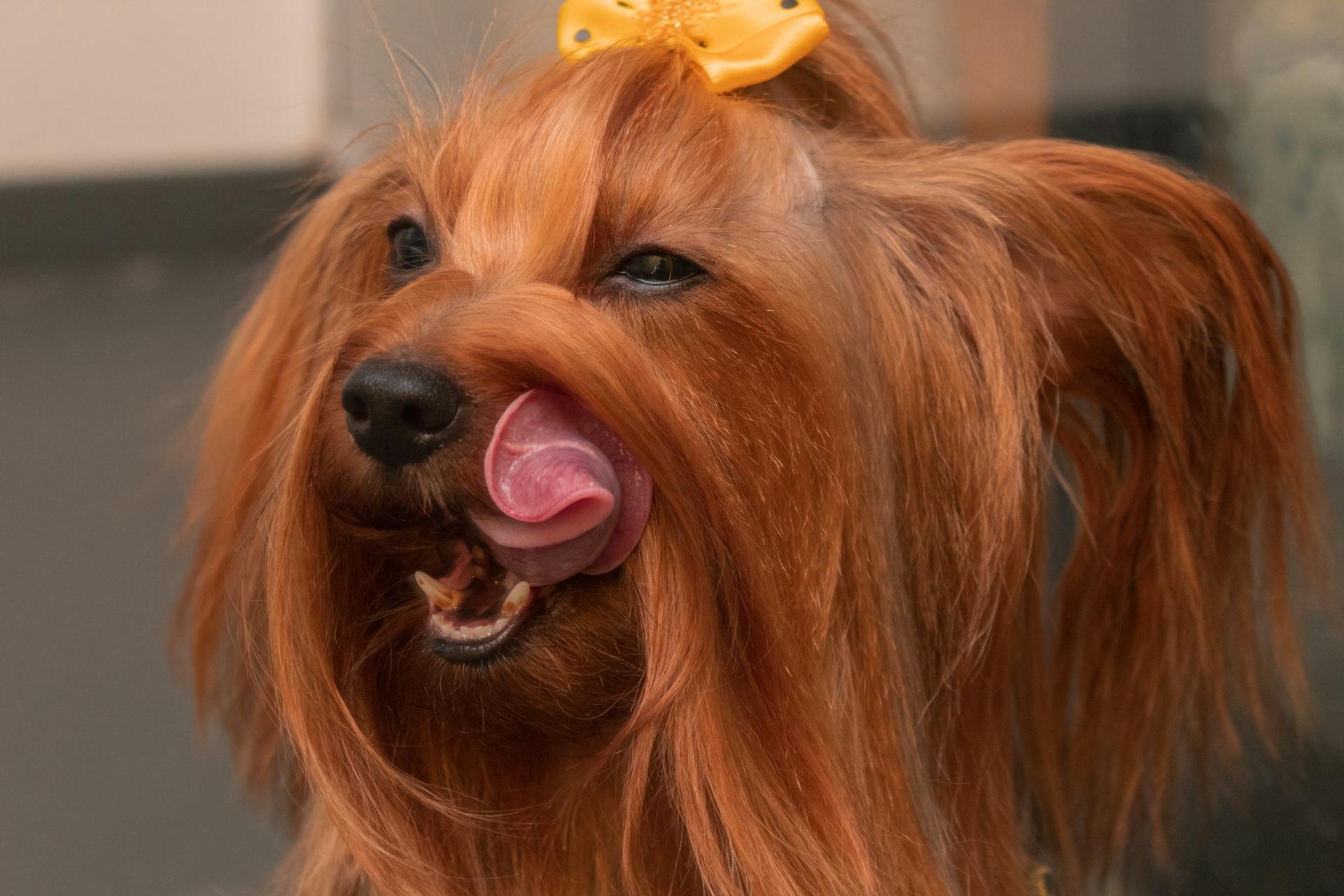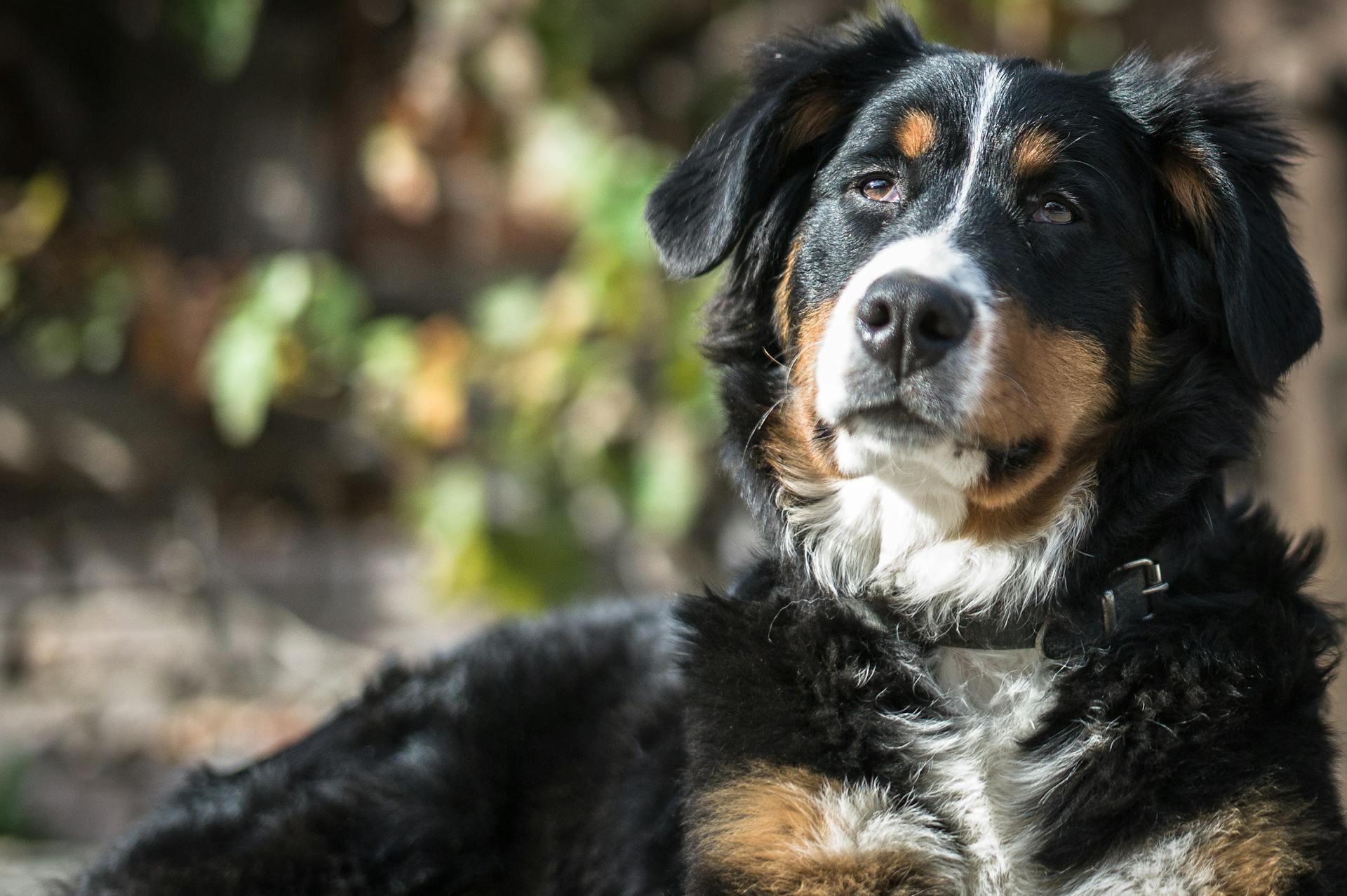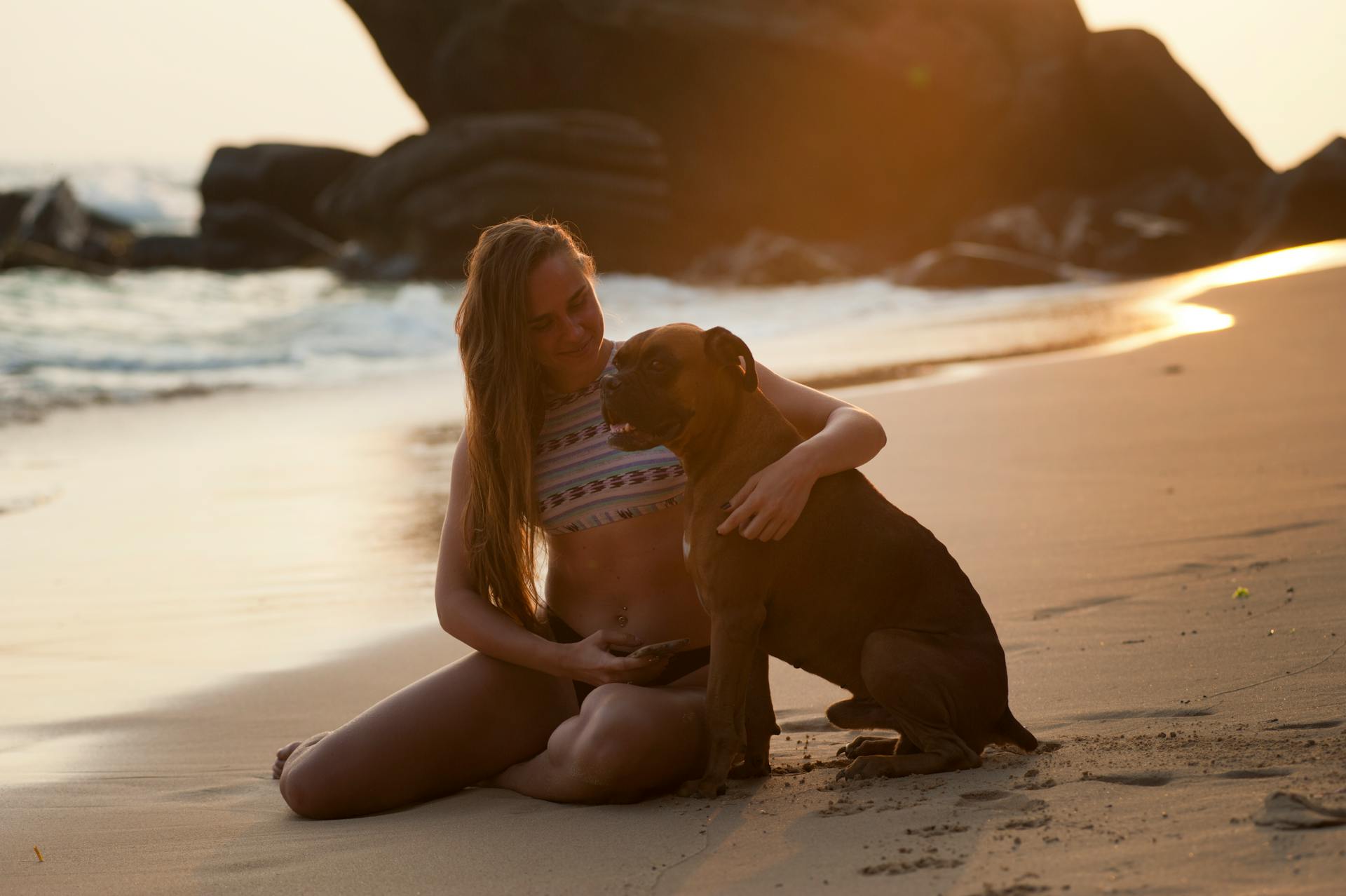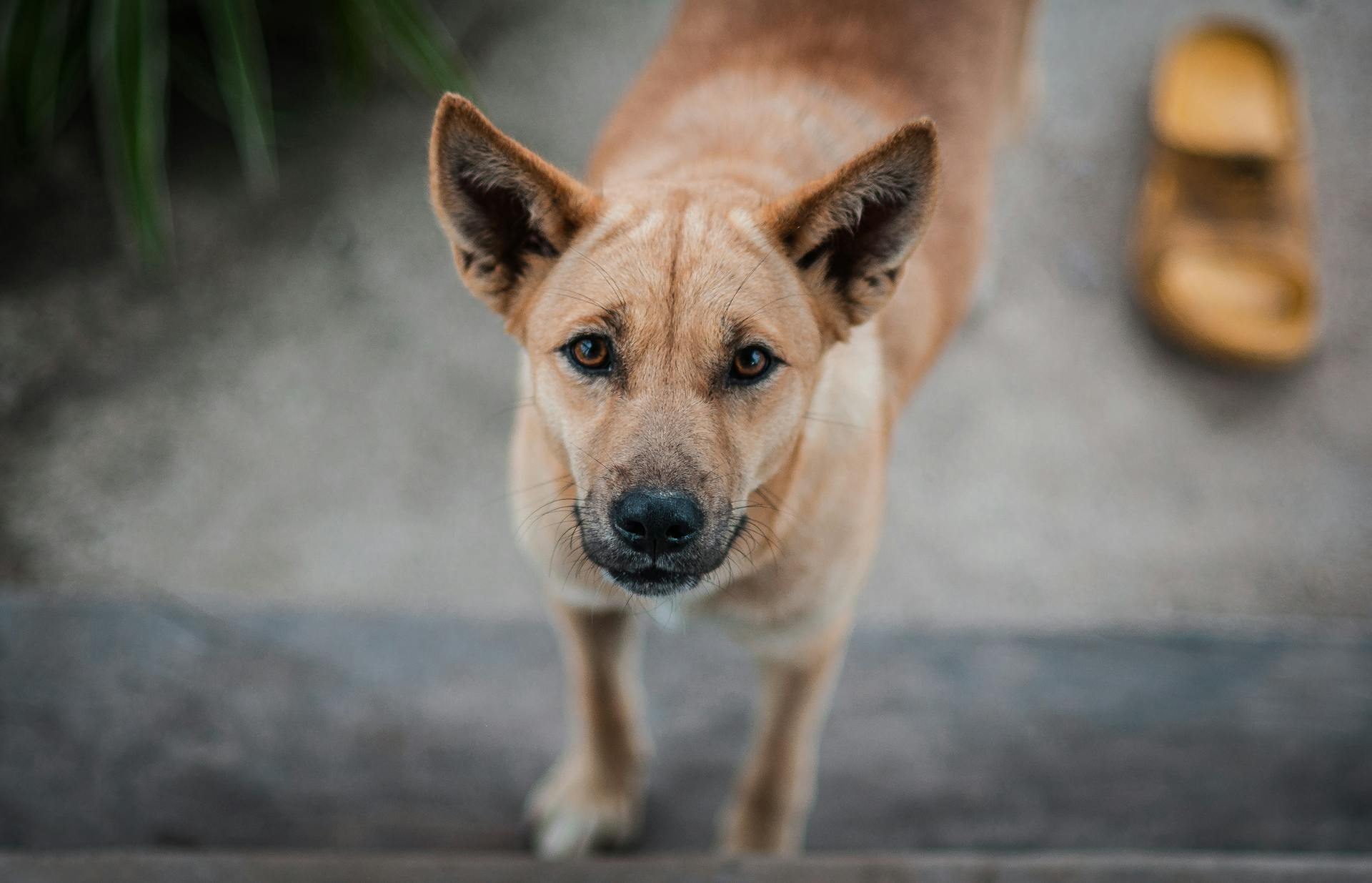
Hair loss in Boxer dogs is a common issue that can be caused by a variety of factors, including genetics, skin allergies, and hormonal imbalances.
Boxer dogs are prone to skin allergies, which can lead to hair loss, particularly around the face, ears, and paws.
A study found that 20% of Boxer dogs suffer from skin allergies, making it a significant contributor to hair loss in the breed.
Boxers can also experience hormonal imbalances, such as Cushing's disease, which can cause hair loss, particularly on the belly and legs.
Some Boxer dogs may also inherit a genetic predisposition to hair loss, known as alopecia areata.
Causes and Symptoms
Hair loss in Boxer dogs can be caused by a variety of factors, including congenital hair loss, which is present from birth, or acquired hair loss, which occurs later in life due to disease or other underlying conditions.
Dogs with congenital hair loss are born with hair follicles that don't develop normally.
Acquired hair loss, on the other hand, can be caused by a range of factors, including trauma, infection, autoimmune disease, and endocrine system abnormalities.
Some common symptoms of alopecia in Boxer dogs include dandruff, itchy skin, patches of dark skin, brittle or dry coat, and shedding more than usual.
Other symptoms may include crusting or red patches around the bald patches, inflammation around bald patches, and skin that is red, inflamed, thickened, oozing, bleeding, malodorous, or pigmented.
It's worth noting that some dogs may not exhibit any symptoms at all, or may only show mild to severe scratching.
Here are some common causes of alopecia in Boxer dogs:
- Trauma such as a burn or repeated action like scratching or chewing
- Infection that damages the hair shaft
- Autoimmune disease where hair follicles are destroyed by the immune system
- Endocrine system abnormalities like Cushing’s or hypothyroidism
- Inflammation that can damage the hair follicles
- Allergic reactions – to food or environmental substances
- Poor diet, which can lead to loss of vibrancy and hair loss in dogs
- Parasites like fleas – these lead to intense itching and chewing
- Overgrooming – dogs excessively groom to address stress or pain
Types of Hair Loss
Hair loss in boxer dogs can be caused by several factors, including genetics, hormonal imbalances, and skin allergies.
Male boxer dogs are more prone to hair loss due to their higher testosterone levels, which can lead to an increase in dihydrotestosterone (DHT), a hormone that contributes to hair thinning.
Boxer dogs can also experience hair loss due to skin allergies, which can be triggered by environmental factors such as pollen, dust, and mold.
Some boxer dogs may inherit a genetic predisposition to hair loss from their parents, with studies suggesting that up to 50% of boxer dogs may experience hair loss due to genetic factors.
Boxer dogs may also experience hair loss due to underlying health conditions, such as hypothyroidism, Cushing's disease, and autoimmune disorders.
In some cases, hair loss in boxer dogs can be a sign of an underlying health issue, such as a skin infection or a parasite infestation.
Discover more: Health Problems with Boxer Dogs
Diagnosis and Treatment
Diagnosis and treatment of hair loss in Boxer dogs can be a complex process, but it's essential to get to the root cause of the issue.
A thorough physical exam by your veterinarian is the single most important step in diagnosing the cause or causes of alopecia. Your vet will take multiple factors into consideration before determining what diagnostics are appropriate in your dog's case.
On a similar theme: Skin Disorders in Dogs Hair Loss
Your veterinarian will examine your dog's skin, looking for any evidence of fleas or flea "dirt" (feces), ticks, or saliva-stained areas such as the feet, tail base, and flanks. They will also note any unusual odors, like yeasty feet smell like Fritos.
To determine the cause of alopecia, your veterinarian may recommend one or more of the following tests:
- Skin scrapes (for Demodectic or Sarcoptic mange)
- Cultures (for bacterial infections)
- Tape preps (looking for bacteria, yeast, and inflammatory cells)
- Black light and/or fungal cultures (for Dermatophytosis or ringworm)
- Ear smear to look for bacteria, yeast, cells, or mites
- Skin testing for allergies
- Possible food trials
- Blood tests (for organ function and endocrine diseases)
- Fecal exam (for parasites)
- Biopsy (for autoimmune diseases or cancer)
Treatment for alopecia in dogs depends entirely on the cause. If it's merely cosmetic and one small lesion, no treatment may be needed. Depending on the cause, one or more of the following may be recommended:
- Food trials
- Medications (antibiotics, antifungals, steroids, antihistamines, anti-parasiticides, anti-inflammatory or anti-pruritic medications)
- Topical therapy (medicated shampoos, sprays, ointments, or dips)
- Surgical removal
- Other treatments may include melatonin, mitotane, and trilostane.
How to Diagnose
Diagnosing alopecia in dogs can be a complex process, but it's essential to determine the underlying cause to choose the right treatment. Your veterinarian will perform a thorough physical exam to consider multiple factors, including age, breed, sex, health status, and prior medical history.
A skin scraping and blood tests are often part of the diagnostic process to rule out parasites, hormonal imbalances, and other underlying conditions. Your vet may also perform a skin culture or biopsy to determine if there's an infection or autoimmune disease present.

To help your vet make an accurate diagnosis, be prepared to answer questions about your dog's history, including diet, parasite medications, and past health issues. This information will help your vet narrow down the possible causes of alopecia.
Here are some common diagnostic tests your vet may recommend:
- Skin scrapes (for Demodectic or Sarcoptic mange)
- Cultures (for bacterial infections)
- Tape preps (looking for bacteria, yeast, and inflammatory cells)
- Black light and/or fungal cultures (for Dermatophytosis or ringworm)
- Ear smear to look for bacteria, yeast, cells, or mites
- Skin testing for allergies
- Possible food trials
- Blood tests (for organ function and endocrine diseases)
- Fecal exam (for parasites)
- Biopsy (for autoimmune diseases or cancer)
Keep in mind that there is no simple "recipe" to fix alopecia in dogs, and figuring out the cause is essential to choosing the right treatment. By working closely with your veterinarian and providing detailed information about your dog's history, you can help determine the underlying cause of alopecia and choose the best course of treatment.
Treatment
Treatment for Alopecia in Dogs can vary depending on the underlying cause and severity of the condition.
Melatonin is often prescribed by veterinary dermatologists to stimulate hair growth in affected dogs, with a success rate of partial to complete hair regrowth in 30-40% of cases.
The dose of melatonin is typically 3 to 9 mg orally every 8-12 hours, and it's usually administered for 3-4 months before reassessment.

Melatonin implants are also available as an alternative treatment option.
In some cases, affected dogs may require treatment of secondary infections or topical therapies to manage the hydration and appearance of the skin.
Food trials may also be recommended to rule out food allergies or sensitivities as a contributing factor to alopecia.
Some medications that may be prescribed to treat alopecia in dogs include antibiotics, antifungals, steroids, antihistamines, anti-parasiticides, anti-inflammatory or anti-pruritic medications such as Apoquel, Atopica, or Cytopoint injections.
Topical therapy, such as medicated shampoos, sprays, ointments, or dips, may also be used to help manage the condition.
Surgical removal is typically reserved for more severe cases of alopecia, and other treatment options may include mitotane and trilostane, although these are not recommended due to potential side effects.
A fresh viewpoint: Homemade Food for Boxer Dogs
Hair Loss Conditions
Boxer dogs are prone to seasonal flank alopecia, a cosmetic type of hair loss that appears in the winter, typically on one or both flanks.
This condition is usually accompanied by a lack of hair, but no sign of skin disease. It's worth noting that Boxers are among the breeds most often affected by this condition.
Some Boxer dogs may also experience pattern baldness, a noninflammatory type of alopecia that causes a thinning of the coat in the ears, neck, head, and chest. This can sometimes be accompanied by darkening of the visible skin.
Inflammatory Disease
Inflammatory disease can cause hair loss in dogs.
Demodectic mange, a type of mange caused by the parasite Demodex canis, can lead to hair loss throughout the entire body.
Inflammatory alopecia can be caused by lesions that are inflamed, crusted, red, scaly, or itchy.
Performing a skin cytology or deep skin scrapings can help diagnose the underlying cause of inflammatory alopecia.
External parasites need to be ruled out in strongly pruritic patients, even if scrapings are negative.
Isoxazoline antiparasitic medications can be used to treat external parasites for one to two months.
Dogs can have multiple conditions contributing to hair loss and/or recurrent infections, such as atopic dermatitis.
Pyoderma, a bacterial skin infection, can cause hair loss due to inflammation and damage to hair follicles.
Dogs that persistently lick or scratch a wound or bite can develop pyoderma.
Seasonal Flank
Seasonal Flank alopecia is a cosmetic type of alopecia that usually appears in the winter.
This condition is characterized by a lack of hair on one or both flanks, with no signs of skin disease. It's worth noting that this condition is relatively rare.
Dogs afflicted by Seasonal Flank alopecia most often are Boxers, Dobermans, and English Bulldogs.
Areata
Areata is a rare autoimmune disease that causes focal areas of hair loss, typically appearing on the head and neck of dogs. It's a distinct condition from other hair loss issues, and its lack of inflammation sets it apart.
Alopecia Areata, a specific type of Areata, is the name given to this condition in dogs, and it's essential to note that it's relatively rare.
Flea Allergy Dermatitis
Flea Allergy Dermatitis is a common condition in dogs that can lead to hair loss. Persistent scratching and biting due to an allergic reaction to flea saliva causes irritated skin.
Dogs with flea allergy dermatitis can become very itchy. This intense itching can be a major source of discomfort for affected dogs.
If left untreated, flea allergy dermatitis can cause hair loss. Hair loss is often a result of the persistent scratching and biting that occurs due to the allergic reaction.
Pattern Baldness
Pattern baldness is a noninflammatory type of alopecia that affects some breeds of dogs.
You'll notice a thinning of the coat in the ears, neck, head, and chest, and in some cases, the visible skin may darken.
Dachshunds are particularly susceptible to pattern baldness, but it's also seen in other breeds such as Chihuahuas, Boston Terriers, Irish Water Spaniels, Whippets, and Bull Terriers.
A different take: Giant Short Haired Dog Breeds
Frequently Asked Questions
Should I be concerned about my dog losing hair?
Normal shedding or breed characteristics may cause hair loss, but sudden hair loss can be a sign of an underlying health issue. Consult a veterinarian to determine the cause and ensure your dog's health
What deficiency causes hair loss in dogs?
Dogs experiencing hair loss may be suffering from a copper deficiency, which causes dull, dry hair and patchy hair loss, or a zinc deficiency, which leads to hair loss, skin issues, and skin thickening
How long does seasonal alopecia last in dogs?
Seasonal alopecia in dogs typically lasts 6-12 months, after which the hair usually regrows. This condition is most common in specific breeds, including Boxers, Bulldogs, Dobermans, and Staffordshire Bull Terriers.
How can I reverse my dogs hair loss?
Reversing your dog's hair loss often involves hormone-related treatments, such as hormone therapy, supplements, or medication, which may take weeks or months to show results
How do you treat alopecia in boxer dogs?
For Boxer dogs with alopecia, melatonin is often considered a safe and cost-effective treatment option, but treatment may not always be necessary if the dog remains healthy and hair regrowth is expected.
Sources
- https://www.dogsnaturallymagazine.com/alopecia-in-dogs/
- https://www.medvet.com/alopecia-x-in-dogs-hair-cycle-arrest/
- https://www.petmd.com/dog/conditions/skin/c_dg_alopecia
- https://www.merckvetmanual.com/dog-owners/skin-disorders-of-dogs/hair-loss-alopecia-in-dogs
- https://www.veterinarypracticenews.com/diagnosing-and-treating-alopecia-in-dogs/
Featured Images: pexels.com


